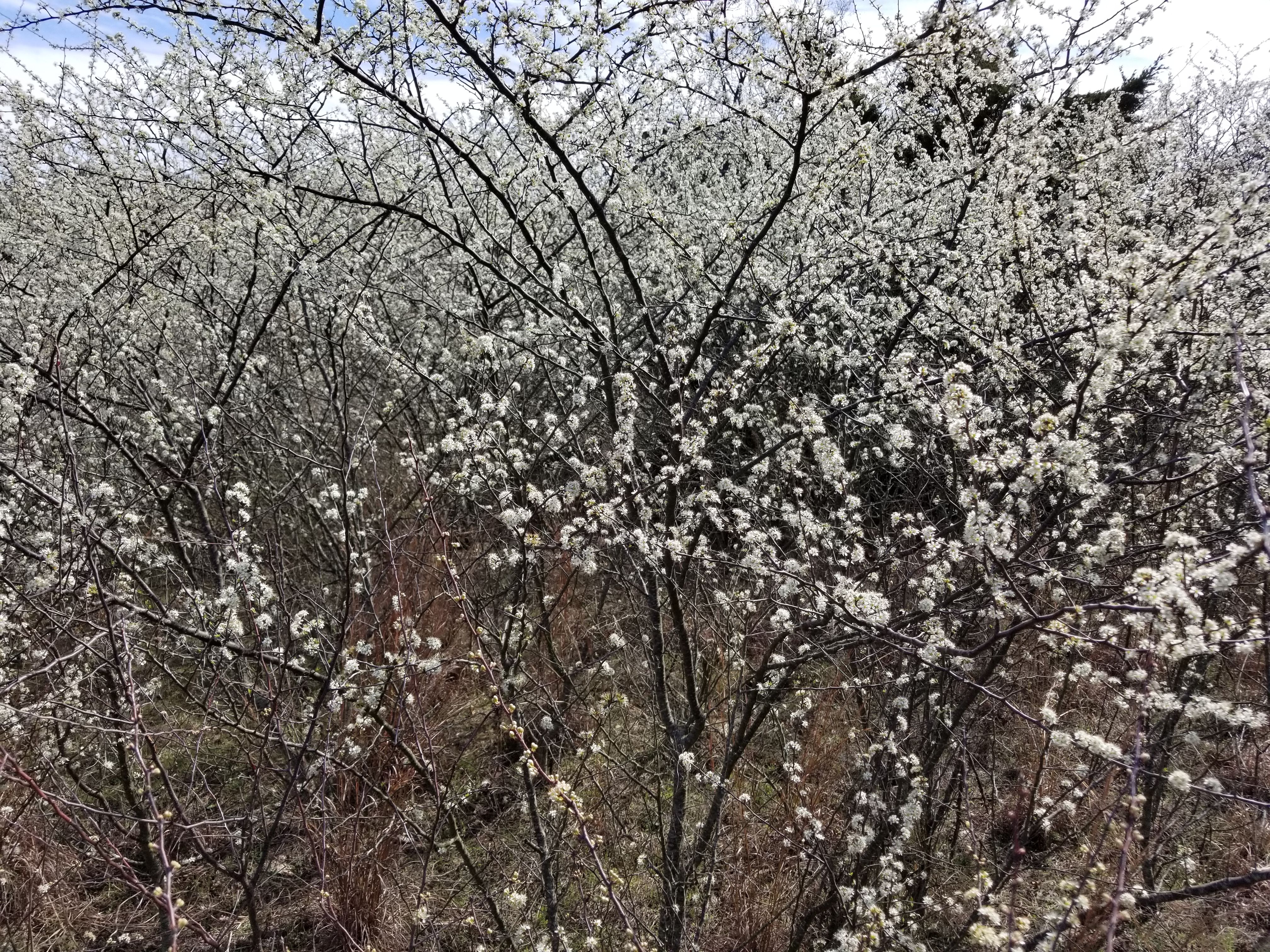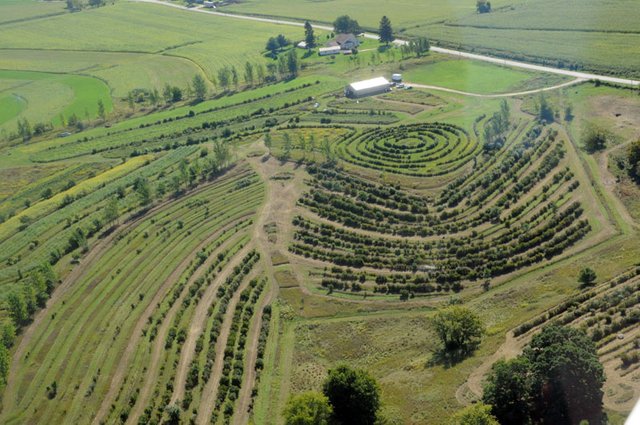Just wanted to say thanks to those who commented and reached out to me about my last post. It means a lot. I wanted to follow up with better clarification about my vision and what I am aiming to accomplish.
Sometime within the few months, I will be starting my own restoration agriculture research farm in North Texas area. I am heavily interested in native plants but will focus my initial work on Neo Hybrid Hazels as developed by Phil Rudder of Badgersett Research Farm. My goal is rather large, to manage around 100 acres or more (as many as I can responsibly take on) as an intensely planted polyculture with animal rotations as appropriate. The dominant plant species will be hazels acting as the long-term, mass-market cash crop. As best I can I will aim to mimic the ecosystems of North Texas, which were historically prairies and savannas.

(Wild Sand Plums in North Texas, sour but prolific!)
When I look at North Texas I see its neglected potential: Pecan/Hickory, Walnut, Plum, Grape, Persimmon, Mulberry, Blackberry and Dewberry…, the list goes on much of which I still do not know. None of that mentions what plants could grow in North Texas with relatively little breeding work, say Chinese chestnut, hazelnut or pinyon pine. Exotics who already are in the region, such as fig and pear are also potential candidates. On top of all this, I am interested in honey locust, oak, and mesquite as animal fodder. In essence, I want to create perennial, ecosystem-based, agriculture and North Texas is one area that interests me. Tree crops and other perennial plant and animal systems are my main focus. Think forest/savanna agriculture. J Russell Smith’s book: Tree Crops: A Permanent Agriculture is a good resource that has inspired me.
My inspirations are Mark Sheppard’s New Forest Farm in Wisconsin (www.forestag.com) and Allan Savory’s Holistic Planned Grazing. Mark’s book Restoration Agriculture is a great source and explanation of his methods on a real working farm. He also has a couple YouTube videos and podcasts available (See: Permaculture Voices Podcast and The Survival Podcast). Together his podcasts are over six hours of information and explanation of his techniques.
His basic concept is to mimic the oak savanna that once dominated so much of central North America. He does this with Chinese Chestnuts, Hazelnuts, Apples, Pears, Grapes, etc. all growing in a very planned, yet chaotic, manner. Between these, he grazes cattle, sheep, pigs, turkey, and chickens. All the animals are on separate rotations and usually, follow each other. He grows cash crop annuals in the rows between the trees as a short-term yield while the system matures. He has done this for 15+ years now and I believe his ideas need to become standard practice.
Last I heard he just received confirmation that his farm out produces industrial corn, in the same area, on a total calorie basis. Granted he has more people working on his farm, but still, that mile marker is huge.
 (New Forest Farm aerial view: taken by New Forest Farm and Mark Shepard)
(New Forest Farm aerial view: taken by New Forest Farm and Mark Shepard)
My current ideas are to start heavily with rotational planned grazing in the beginning and slowly adjust the as times goes on. Using animals to jumpstart ecological cycles while providing income as my long-term plant systems establish. As I stated earlier I am not set on any species, but am considering Guinea Hogs as one of my first animal introductions. This breed is small and docile, hardy on forage/pasture and reaches market weight in less than a year. If I can combine that with another complimentary species of animal (maybe chicken or turkey) I should have a solid basis to successfully grow long-term tree and shrub crops. Setting up the system like this I should have reduced feed costs for my animals while simultaneously reducing the need to buy fertilizer for my plants.
Short term, 1-5 years, I would expect to earn the majority of my money off-farm, but with ever increasing animal productivity on the farm. The natural history of Texas and North America gives us a strong indication of the kind and degree of animal biomass that the land is capable of. My plan would be to start off with simple animal systems and management, with a shift toward higher numbers and greater species complexity as the land, time, money and management allow.
Middle term, 5-20 years, I would expect to transition to land management full time, with the majority emphasis being on the synergistic relationship between plants and animals. Animal productivity will most likely peak in this time frame, just as the tree populations really start to dominate, both the ecology and finances of the farm.
Long-term, 20+ years, I would expect to have an economically and ecologically productive agricultural landscape. I would expect ever-increasing maturity in nut and timber trees, with the majority of income coming from perennial tree crops. Animal systems will be based heavily on tree crops and will maintain their essential nutrient cycling roles as needed and appropriate.
I am under no illusions as to the task I have in creating this. It will be hard, I have no land, I do not know enough, the genetics for much of my target systems do not exist yet and finding markets for my products will be as much work and time as the farm itself. Land acquisition is huge and may take me much longer than I would care to admit, but I need to start somewhere.
I do know that the need for a different agriculture is immense and if we do not find it soon we risk losing much more than we have already lost. I wish to create that change and am asking for guidance. As much as anything I need critical minds which will help me develop better, more robust, systems.
If you have any questions feel free to ask them. I am interested in hearing your honest thoughts about this endeavor.
I believe your idea is great. There are many ways to yield crops and raise livestock, other than the standard, easy way. However, the easy way, the chemical way produces the most for the most money. Even though it is not the right or best way.
This summer I will be building a bee garden to help support and hopefully help grow the pollinating bee species in my area.Next year I am hoping to have beehives that I will be taking care of. I am currently taking classes to learn how. I am also hoping by bringing the bees into my yard I will yield pumpkins this year. I planted pumpkins last year but they did not produce fruit.
Good luck with your endevor. Have you looked into grants through local colleges? Most local universities offer grants to purchase land and supplies needed to grow crops or to fund new eduational possiblities. Just a thought :)
Good luck again and it would be nice to hear how your plan progressees :)
Downvoting a post can decrease pending rewards and make it less visible. Common reasons:
Submit
Thanks, I will not argue with the productivity results for modern industrial agriculture, but the "more profitable" claim is complex. Because modern AG is based on a few commodity grains and those commodities command a world price most farmers have steep global competition. Only the biggest farmers with the largest fields make money and even those are supported by the government through subsidies.
Subsidies are important because they not only are a transfer to rural areas (helping to balance the productivity gains of industrialism), but they also moderate the swings in food prices for the population as a whole. The adverse side of these subsidies is that they are propping up a fragile agricultural system that needs to innovate for resilience and sustainability.
Bees are a long term goal of mine also!
Downvoting a post can decrease pending rewards and make it less visible. Common reasons:
Submit
Hi, I was speaking from a smaller farmer perspective on the chemical way yielding the most for the most profit. We have a lot of farmers in our community and they use large amounts of chemicals and it has polluted our local waterways. I believe a more organic approach should be used. These are several studies that show the harmful effects on the environment, animal population, waterways, and the consumer.
Subsidies are very important, a lot of farmers would not survive without them. There are a lot here that depend greatly on them and some that have expanded in to branches of agricultural with them. However, they should be helping the farmer yeild a less chemical supported crops.
Downvoting a post can decrease pending rewards and make it less visible. Common reasons:
Submit
I agree governments could do a lot more to promote a more sustainable agriculture. One thing I think public funds should be put toward is the basic research of new crops more adapted to the local conditions and particularly woody crops.
Downvoting a post can decrease pending rewards and make it less visible. Common reasons:
Submit
I 100% agree. There would be a lot of benefit worldwide.
Downvoting a post can decrease pending rewards and make it less visible. Common reasons:
Submit
Congratulations, your post was discovered and featured by @OCD in its daily compilation 245!
You can follow @ocd – learn more about the project and see other Gems! We strive for transparency.
If you would like your posts to be resteemed by @ocd to reach a bigger audience, use the tag #ocd-resteem. You can read about it here.
@ocd now has a witness. You can vote for @ocd-witness with SteemConnect or on Steemit Witnesses to help support other undervalued authors!
Downvoting a post can decrease pending rewards and make it less visible. Common reasons:
Submit
Thanks for this great post and most especially for the inspiration and bold step you want to take in investing in sustainable farming. Will read more about the New Forest Farm as well as share with you our thoughts about it. It inspires us to connect with more eco-people and we look forward to learning from each other. @thegreens and @dukefranky
Downvoting a post can decrease pending rewards and make it less visible. Common reasons:
Submit
followed! :)
Downvoting a post can decrease pending rewards and make it less visible. Common reasons:
Submit
One you find your land everything will start to fall into place. Einstein said: “The more I learn, the more I realize how much I don't know.” If I add ..."the more I am driven to know" to this statement I think that sums up the mentality of a person who aims to be steward of the land. There are continually new discoveries, adaptations and challenges all around you. It's all quite remarkable.
There are some really inspiring people on steemit - you'll find a really supportive community here. I look forward to following your journey!
Downvoting a post can decrease pending rewards and make it less visible. Common reasons:
Submit
Thank you, so far the community here has been very supportive!
Downvoting a post can decrease pending rewards and make it less visible. Common reasons:
Submit